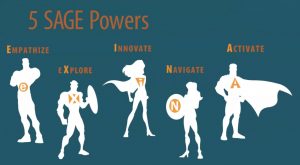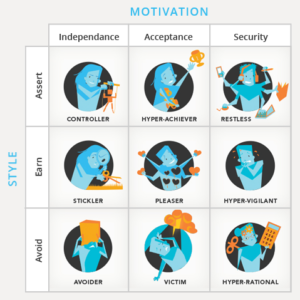What if your resilience and your entrepreneurial mindset were things that you could exercise, train and enhance? Just like you would an ab or a bicep.
If you’ve ever suffered from swings in mood and self-belief in your time as a business owner (in other words ‘if you run your own business’), this article is for you.
You’ll know that at best these periods can have a serious impact on productivity and results. At worst they can become habit forming turn into a vicious cycle.
What is an Entrepreneurial Mindset in the first place?
I suspect we’d all have marginally differing views on this.
For my money, it’s the ability to see the world in terms of challenges to be addressed rather than problems to be endured.
This requires you to put issues and events into context, to be proactive and to stay focussed whilst others are losing their heads.
NB: The framework in ‘The 7 Habits of Highly Effective People’ is as good as it gets for this – especially the first 3.
Most resources seem to focus on recovering your Entrepreneurial Mindset rather than enhancing it.
You’ll have no doubt developed your own ‘hacks’ over time to help you reset when you’ve been knocked off your entrepreneurial balance. Some listen to podcasts; some seek out the company of certain friends or trusted confidants. You might hit the gym, revisit your big business plan – or just get out in the fresh air.
These are all great – for treating the symptoms and limiting their impact.
But what do you do to reduce the cause of the symptoms? How would you become more resilient so that you are derailed less often? And less severely? And for shorter periods of time?
I’d read books as well-known as Atomic Habits by James Clear and The Chimp Paradox by Prof Steve Peters and as obscure as Outwitting The Devil by Napoleon Hill. And as good as they were, it didn’t feel like they really helped me address this root cause.
And then I came across Shirzad Chamine and his book Positive Intelligence.
What is Positive Intelligence?
The core premise is that we all have the ability to react to issues, events and challenges in a constructive way – and also in a way that does neither us nor those around us any favours.
The positive aspect to our make-up is called the Sage mind and your Saboteurs take care of the not-so helpful aspects of our characters.
The whole thing – and the balance between your Sage and your Saboteurs – is summed up as your PQ score or Positive Intelligence Quotient.
Your Sage Mind
In Sage mode – ie when your PQ holds sway – you are constructive, creative and proactive.
All great traits for the Entrepreneurial Mind to have.
This would be summarised by the words:

- Empathise: the ability to understand the feelings of others
- Explore: maintaining a curious and non-judgmental perspective
- Innovate: approaching situations with a creative and open mindset
- Navigate: adapting effectively to changing circumstances and challenges
- Activate: taking decisive action and maintaining a positive focus
Your Saboteurs
Everyone has exactly the same saboteurs lurking about. Individually, these are:

- Judge: constantly evaluates and criticises oneself and others
- Stickler: sets high standards and is perfectionistic
- Pleaser: seeks validation and approval from others
- Hyper-achiever: driven by the need to constantly achieve and accomplish
- Hyper-rational: over-analyses situations and avoids emotions
- Hyper-vigilant: constantly anticipates problems and dangers
- Restless: struggles with staying ‘present’ and being content
- Avoider: evades challenges or conflicts to maintain comfort
- Controller: attempts to control situations and people
- Victim: focuses on painful feelings as a way of attracting sympathy / empathy
Which ones feature most frequently in your make-up comes down to nature, nurture and environment. We’ll each have our own 2 or 3 ‘regulars’ – but the Judge tends to feature most strongly for most people.
Now some of you may look at this list and conclude that your saboteurs are actually a positive. In that they are helping you achieve your best and protecting you in the process.
And it’s true that all of these characteristics were hard-wired into us for very sensible reasons – to keep us safe.
But, like anything else, too much of a good thing is usually a bad thing.
If you regret the way you’ve reacted to something or don’t feel like you’re reaching your potential, the short answer is that one or more of these saboteurs will be tripping you up.
The next – more useful question might be: ‘Where is your Positive Intelligence’?
Where this got really interesting and valuable for me, was understanding that when we are in Sage mode, the activity takes place in a completely different area of the brain from the area that lights up when our Saboteurs are on the rampage.
And the crucial thing to understand is that our brains can only choose one or the other for any given situation.
This makes common sense when think about it: You can’t be judgemental and curious at the same time. It just doesn’t work like that.
It comes down to the difference between Survive & Thrive
Our brains are designed to operate in one of two distinct ways.
To help us survive in times of uncertainty and stress.
And then when the danger or uncertainty has passed, to help us thrive.
And most of us have a slight bias towards ‘survive’ – it’s a ‘safety-first’ approach to our environments.
The truly valuable realisation is that our brains actively suppress activity in our Sage minds when we’re in Saboteur (Survival) mode. And vice versa.
That’s right. When we’re in Survive Mode, our brains decide for us that we can’t cope with new ideas, with innovation, with seeing things from a different perspective.
How does this equate to you, your business and your Entrepreneurial Mindset?
Let’s say you lose your biggest client the day after missing out on signing a big, shiny new customer.
24 hours before you were optimistic about growing your business and all the things that could bring.
One rotation of the earth later and you’re pondering cost-cutting and mulling over those big questions. Is there a place in the market for my product? Is the economy going off a cliff? Am I up to it?
At this point what we need is our Sage Minds to kick in. We need curiosity and new ideas. We want to be able to focus on what we can control rather than what scares us. And we need decisive action.
And at just this point our brains shut off that area of our brains and divert all power to the Survival area of our minds.
This is the part that focusses on the problem not the solution. And which finds a snag in every possible solution, so we decide it can’t possibly work for us.
Leading you to endless and fruitless ‘analysis’ which is in reality just the process of being stressed.
The antithesis of the Entrepreneurial Mindset you need.
So what determines which mode the brain decides to kick into?
It turns out that the brain chooses which mode to activate based to a large degree on practice and repetition.
The actual process is that the brain generates an electrical signal – a threat response – and off that signal goes. This signal travels down a neural pathway to either your Sage mind or to your Saboteurs.
And neural pathways are very like any other pathways.
When you use them a lot them become wider and easier to find and go down.
When you don’t use them much, they become over-grown and hard to access.
So, in effect, you can build this response – responding with your best Entrepreneurial Mindset – like you would any other muscle.
A training regime for your Entrepreneurial Mindset
For this part I’ll just outline Shirzad Chamine’s suggestions, which start with preventative measures and then move onto exercises to help you reboot. This amounts to retracing your steps back along the Saboteur’s neural pathway and to choose the Sage path instead.
- PQ Reps: in short, this is meditation and practicing the habit / art of being ‘present’
- PQ Gym: set aside time in the day to actively do this. Little and often is ideal but anything is better than nothing
- Saboteur Interceptor: label your saboteurs when they start to take over
- Saboteur Assessor: keep a journal of them and their impact. (You can also take a Saboteur Assessment on the PQ website)
- Sage 360: continuously and consciously practice activating your Sage mode in different areas of your life
- Visualisation: role-play how you could react with your Sage mind in certain situations
How long will it take?
It’s a bit like getting fit – everyone has a different starting point and it depends how much you exercise. Or as my nan would’ve said ‘how long is a piece of string?’.
Also, like getting fit, it’s easy fall out of the habit or get disheartened if you decide the results aren’t ‘visible’ enough.
A great start would be to set yourself a 90-day challenge and stick with it come what may.
In conclusion
Everyone’s Entrepreneurial Mindset gets derailed – the key is how often, how badly and for how long.
Some people have a bad week or month. Some have a bad hour or day.
But with practice and exercise you can decrease the frequency, impact and duration of these unproductive periods.
You can improve your mental well-being, emotional resilience and decision-making.
And be ‘you on a great day’ – constructive, creative and proactive – more and more often.
Call to Action
If you find this interesting and fancy a chat, please do book in for a zoom coffee.




